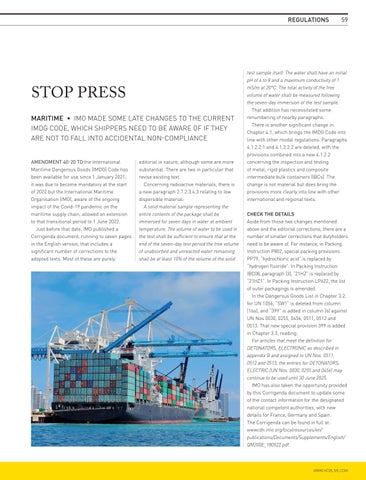REGULATIONS 59
STOP PRESS MARITIME • IMO MADE SOME LATE CHANGES TO THE CURRENT IMDG CODE, WHICH SHIPPERS NEED TO BE AWARE OF IF THEY ARE NOT TO FALL INTO ACCIDENTAL NON-COMPLIANCE AMENDMENT 40-20 TO the International Maritime Dangerous Goods (IMDG) Code has been available for use since 1 January 2021; it was due to become mandatory at the start of 2022 but the International Maritime Organisation (IMO), aware of the ongoing impact of the Covid-19 pandemic on the maritime supply chain, allowed an extension to that transitional period to 1 June 2022. Just before that date, IMO published a Corrigenda document, running to seven pages in the English version, that includes a significant number of corrections to the adopted texts. Most of these are purely
editorial in nature, although some are more substantial. There are two in particular that revise existing text. Concerning radioactive materials, there is a new paragraph 2.7.2.3.4.3 relating to low dispersible material: A solid material sample representing the entire contents of the package shall be immersed for seven days in water at ambient temperature. The volume of water to be used in the test shall be sufficient to ensure that at the end of the seven-day test period the free volume of unabsorbed and unreacted water remaining shall be at least 10% of the volume of the solid
test sample itself. The water shall have an initial pH of 6 to 8 and a maximum conductivity of 1 mS/m at 20°C. The total activity of the free volume of water shall be measured following the seven-day immersion of the test sample. That addition has necessitated some renumbering of nearby paragraphs. There is another significant change in Chapter 4.1, which brings the IMDG Code into line with other modal regulations. Paragraphs 4.1.2.2.1 and 4.1.2.2.2 are deleted, with the provisions combined into a new 4.1.2.2 concerning the inspection and testing of metal, rigid plastics and composite intermediate bulk containers (IBCs). The change is not material but does bring the provisions more clearly into line with other international and regional texts. CHECK THE DETAILS Aside from those two changes mentioned above and the editorial corrections, there are a number of smaller corrections that dutyholders need to be aware of. For instance, in Packing Instruction P802, special packing provisions PP79, “hydrochloric acid” is replaced by “hydrogen fluoride”. In Packing Instruction IBC08, paragraph (3), “21HZ” is replaced by “21HZ1”. In Packing Instruction LP622, the list of outer packagings is amended. In the Dangerous Goods List in Chapter 3.2, for UN 1056, “SW1” is deleted from column (16a), and “399” is added in column (6) against UN Nos 0030, 0255, 0456, 0511, 0512 and 0513. That new special provision 399 is added in Chapter 3.3, reading: For articles that meet the definition for DETONATORS, ELECTRONIC as described in appendix B and assigned to UN Nos. 0511, 0512 and 0513, the entries for DETONATORS, ELECTRIC (UN Nos. 0030, 0255 and 0456) may continue to be used until 30 June 2025. IMO has also taken the opportunity provided by this Corrigenda document to update some of the contact information for the designated national competent authorities, with new details for France, Germany and Spain. The Corrigenda can be found in full at: wwwcdn.imo.org/localresources/en/ publications/Documents/Supplements/English/ QM200E_180522.pdf.
WWW.HCBLIVE.COM































